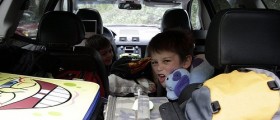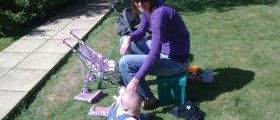
Children need to stay healthy, happy and, overall, safe from all that can possibly hurt them. Therefore, there are specific sets of rules that parents and caregivers need to bear in mind once taking good care of children. The lines below will provide you with all the necessary information you need to know on the subject of child safety.
Safety First
Various factors of child safety need to be taken into consideration while you are doing your best to prevent injuries or unwanted situations from affecting the child you are taking care of. The household has to be free of any potentially dangerous tools, object or other items. Also, if you are not at home, you need to stay in touch with whoever is taking care of your children and make these kinds of arrangements in advance.
Tips for Your Child's Safety
First and foremost, do not ever leave children unattended in a car; not even when there is only a single child inside.
Next, when you are driving your child or children to the day care center, make sure that they are sitting in the back seat, protected, secured and busy playing with toys, preferably stuffed animals. Make sure that the day care center needs your confirmation in any instances of the child's absence on a scheduled date.
Speaking of cars, keep all vehicles and garages locked. Additionally, activate your hand brakes whenever the cars are not used, keeping the keys at a safe distance from the children. When you drive more children to the day care, make sure that all of them leave the vehicle before locking it and, if a child is missing upon this chec-kup, check the trunk and other hidden places in the car.
If your child is using the child safety seat in the car, due to his/her age, make sure you use the rearward facing models. These are known to be the best, in terms of safety. Still, be careful and never place this kind of seat in front of an airbag container. Later on, when the child is old enough, he/she can sit in a frontward facing seats, safely placed in a harness. Once the child outgrows these seats, use a booster seat. Finally, once the child is older than 13, use regular seat belts for his/her safety and protection during driving.
While your children are driving with you, in order to keep them safe, opt for drive-thru rather than other forms of restaurants or shops and, when buying gas for the car, pay by credit card without stepping out of the vehicle.
If you decide to ask a babysitter to keep an eye on your children when you cannot, make sure that the person in charge has your number. Also, keep your phone on and fully charged, so that you can be available during the whole time.Choosing the Right Safety Seat for Your Child
If you are using old or used child safety seats, have them checked for any possible malfunctions or flaws by taking the seat you own to a certified technician. He/she will make sure that the seat is properly installed in the car, safe from damage or any other problems. Additionally, he/she will check whether the specific model of the seat you own has been recalled.
The seat needs to be properly adjusted for your child and, thus, the technician will make sure everything is excellent and compatible regarding the child's size and age, giving the necessary instructions to the parent. So, whenever your child's caretaker is using the car, show him/her how to install and use the safety seat properly. If the seat gets used in other cars, make sure that it is not wrongly mounted and secured.
Other Factors about Keeping Your Child Safe
When you take babies younger than 6 months out in the sun, make sure you apply sunscreen on their skin, dress them in long-sleeved, lightweight clothes and protect their necks and heads with lightweight caps or hats. Older children can wear sunglasses. However, make sure you keep the children in the shade for as long as possible. Reapply the sunscreen once the effect has gone.
If you decide to take the children to a swimming pool, stay with them at all times. If you own a pool, install fences around it so that you prevent children from reaching it unattended. If the child cannot swim, use life vests rather than other forms of inflatable swimming aids.
When you take the child to open water swimming, choose spots with lifeguards and stay near the child at all times. If the flowing water is fast and difficult to swim in, do not allow the child to enter it.
To conclude, there are numerous factors of safety you need to bear in mind each time you leave your child at home or take him/her to swimming, outings or other trips. So, stay sharp, alert and make sure you have covered all the safety measures at all times.

















Your thoughts on this
Loading...